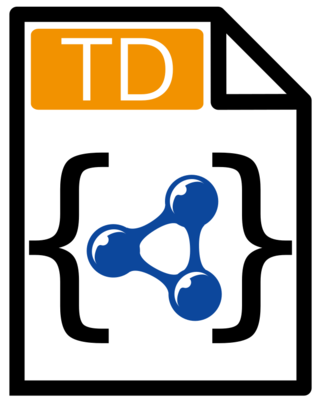Related Research Articles

The Dublin Core, also known as the Dublin Core Metadata Element Set (DCMES), is a set of fifteen main metadata items for describing digital or physical resources. The Dublin Core Metadata Initiative (DCMI) is responsible for formulating the Dublin Core; DCMI is a project of the Association for Information Science and Technology (ASIS&T), a non-profit organization.
A Uniform Resource Identifier (URI) is a unique sequence of characters that identifies a logical or physical resource used by web technologies. URIs may be used to identify anything, including real-world objects, such as people and places, concepts, or information resources such as web pages and books. Some URIs provide a means of locating and retrieving information resources on a network ; these are Uniform Resource Locators (URLs). A URL provides the location of the resource. A URI identifies the resource by name at the specified location or URL. Other URIs provide only a unique name, without a means of locating or retrieving the resource or information about it, these are Uniform Resource Names (URNs). The web technologies that use URIs are not limited to web browsers. URIs are used to identify anything described using the Resource Description Framework (RDF), for example, concepts that are part of an ontology defined using the Web Ontology Language (OWL), and people who are described using the Friend of a Friend vocabulary would each have an individual URI.
The Resource Description Framework (RDF) is a World Wide Web Consortium (W3C) standard originally designed as a data model for metadata. It has come to be used as a general method for description and exchange of graph data. RDF provides a variety of syntax notations and data serialization formats, with Turtle currently being the most widely used notation.
A Uniform Resource Name (URN) is a Uniform Resource Identifier (URI) that uses the urn scheme. URNs are globally unique persistent identifiers assigned within defined namespaces so they will be available for a long period of time, even after the resource which they identify ceases to exist or becomes unavailable. URNs cannot be used to directly locate an item and need not be resolvable, as they are simply templates that another parser may use to find an item.

A digital object identifier (DOI) is a persistent identifier or handle used to uniquely identify various objects, standardized by the International Organization for Standardization (ISO). DOIs are an implementation of the Handle System; they also fit within the URI system. They are widely used to identify academic, professional, and government information, such as journal articles, research reports, data sets, and official publications. DOIs have also been used to identify other types of information resources, such as commercial videos.
Web standards are the formal, non-proprietary standards and other technical specifications that define and describe aspects of the World Wide Web. In recent years, the term has been more frequently associated with the trend of endorsing a set of standardized best practices for building web sites, and a philosophy of web design and development that includes those methods.
The Internationalized Resource Identifier (IRI) is an internet protocol standard which builds on the Uniform Resource Identifier (URI) protocol by greatly expanding the set of permitted characters. It was defined by the Internet Engineering Task Force (IETF) in 2005 in RFC 3987. While URIs are limited to a subset of the US-ASCII character set, IRIs may additionally contain most characters from the Universal Character Set, including Chinese, Japanese, Korean, and Cyrillic characters.
A persistent uniform resource locator (PURL) is a uniform resource locator (URL) that is used to redirect to the location of the requested web resource. PURLs redirect HTTP clients using HTTP status codes.
A Name Authority Pointer (NAPTR) is a type of resource record in the Domain Name System of the Internet.
URL encoding, officially known as percent-encoding, is a method to encode arbitrary data in a Uniform Resource Identifier (URI) using only the limited US-ASCII characters legal within a URI. Although it is known as URL encoding, it is also used more generally within the main Uniform Resource Identifier (URI) set, which includes both Uniform Resource Locator (URL) and Uniform Resource Name (URN). As such, it is also used in the preparation of data of the application/x-www-form-urlencoded media type, as is often used in the submission of HTML form data in HTTP requests.
RDFa or Resource Description Framework in Attributes is a W3C Recommendation that adds a set of attribute-level extensions to HTML, XHTML and various XML-based document types for embedding rich metadata within Web documents. The Resource Description Framework (RDF) data-model mapping enables its use for embedding RDF subject-predicate-object expressions within XHTML documents. It also enables the extraction of RDF model triples by compliant user agents.

Michael Mealling is co-founder of Pipefish Inc, and was the cofounder, Chief Financial Officer (CFO) and Vice President of Business Development of Masten Space Systems, CEO of Refactored Networks, long time participant within the IETF, a Space Frontier Foundation Advocate, and a former Director of the Moon Society. He operates a blog site called Rocketforge and has been interviewed twice on The Space Show and twice on SpaceVidcast.
The Handle System is the Corporation for National Research Initiatives's proprietary registry assigning persistent identifiers, or handles, to information resources, and for resolving "those handles into the information necessary to locate, access, and otherwise make use of the resources".

The HTTP Location header field is returned in responses from an HTTP server under two circumstances:
- To ask a web browser to load a different web page. In this circumstance, the Location header should be sent with an HTTP status code of 3xx. It is passed as part of the response by a web server when the requested URI has:
- To provide information about the location of a newly created resource. In this circumstance, the Location header should be sent with an HTTP status code of 201 or 202.

An Archival Resource Key (ARK) is a multi-purpose URL suited to being a persistent identifier for information objects of any type. It is widely used by libraries, data centers, archives, museums, publishers, and government agencies to provide reliable references to scholarly, scientific, and cultural objects. In 2019 it was registered as a Uniform Resource Identifier (URI).
An Extensible Resource Identifier is a scheme and resolution protocol for abstract identifiers compatible with Uniform Resource Identifiers and Internationalized Resource Identifiers, developed by the XRI Technical Committee at OASIS. The goal of XRI was a standard syntax and discovery format for abstract, structured identifiers that are domain-, location-, application-, and transport-independent, so they can be shared across any number of domains, directories, and interaction protocols.
A Uniform Resource Locator (URL), colloquially termed a web address, is a reference to a web resource that specifies its location on a computer network and a mechanism for retrieving it. A URL is a specific type of Uniform Resource Identifier (URI), although many people use the two terms interchangeably. URLs occur most commonly to reference web pages (HTTP/HTTPS) but are also used for file transfer (FTP), email (mailto), database access (JDBC), and many other applications.

A well-known URI is a Uniform Resource Identifier for URL path prefixes that start with /.well-known/. They are implemented in webservers so that requests to the servers for well-known services or information are available at URLs consistent well-known locations across servers.
Larry Melvin Masinter is an early internet pioneer and ACM Fellow. After attending Stanford University, he became a Principal Scientist of Xerox Artificial Intelligence Systems and author or coauthor of 26 of the Internet Engineering Task Force's Requests for Comments.

The Thing Description (TD) (or W3C WoT Thing Description (TD)) is a royalty-free, open information model with a JSON based representation format for the Internet of Things (IoT). A TD provides a unified way to describe the capabilities of an IoT device or service with its offered data model and functions, protocol usage, and further metadata. Using Thing Descriptions help reduce the complexity of integrating IoT devices and their capabilities into IoT applications.
References
- 1 2 Daniel, Ron Jr.; Mealling, Michael (21 November 1994). "URC Scenarios and Requirements". IETF . Retrieved 2022-02-06.
- ↑ IETF URI Working Group (14 April 1994). "URN to URC resolution scenario". IETF . Retrieved 2013-03-07.
- ↑ Mealling, Michael (8 July 1994). "Encoding and Use of Uniform Resource Characteristics". IETF . Retrieved 2013-03-07.
- ↑ Hoffman, Paul E.; Daniel, Ron Jr. (21 April 1995). "Trivial URC Syntax: urc0". IETF . Retrieved 2013-03-07.
- ↑ "Proceedings of the Twenty-Fifth Internet Engineering Task Force" (PDF). IETF. 16 November 1992. p. 503.
- ↑ Kunze, John (January 2001). "A Metadata Kernel for Electronic Permanence". Proceedings of the International Conference on Dublin Core and Metadata Applications 2001.
- ↑ "Uniform Resource Characteristics/Citations (URCs)". UKOLN Metadata Group. 10 June 1998. Retrieved 2022-02-06.
- ↑ Sollins, Karen; Masinter, Larry (December 1994). "Functional Requirements for Uniform Resource Names". IETF . Retrieved 2013-03-07.